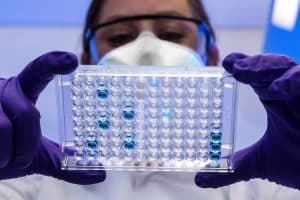Vertex and CRISPR Therapeutics Announce EMA Marketing Authorization Application Validation for CRISPR/Cas9 GeneEdited Therapy, exagamglogene autotemcel (exa
pharmafile | January 25, 2023 | News story | Business Services |
LONDON, UK and ZUG, Switzerland, January 25, 2023 – Vertex Pharmaceuticals (Europe) and CRISPR Therapeutics (Nasdaq: CRSP) today announced that the European Medicines Agency (EMA) has validated the Marketing Authorization Application of exa-cel for the treatment of sickle cell disease (SCD) and transfusion-dependent beta thalassemia (TDT). The submission is supported by two global Phase 3 studies investigating exa-cel as a potential one-time therapy for people with SCD or TDT. “Today marks a significant milestone in our efforts to bring a new one-time therapy to people living with sickle cell disease or transfusion-dependent beta thalassemia,” said Nia Tatsis Ph.D., Executive Vice President, Chief Regulatory and Quality Officer. “We look forward to working with the EMA on our application, the first for a CRISPR-based therapy for a genetic disease.” Exa-cel has been granted Orphan Drug Designation from the European Commission, as well as Priority Medicines (PRIME) designation for both SCD and TDT from the EMA. Vertex has also begun the rolling Biologics License Application (BLA) submission to the U.S. Food and Drug Administration and expects to complete the BLA by the end of the first quarter. About exagamglogene autotemcel (exa-cel) Exa-cel, formerly known as CTX001™, is an investigational, autologous, ex vivo CRISPR/Cas9 gene-edited therapy that is being evaluated for patients with SCD or TDT, in which a patient’s own hematopoietic stem cells are edited to produce high levels of fetal hemoglobin (HbF; hemoglobin F) in red blood cells. HbF is the form of the oxygen-carrying hemoglobin that is naturally present during fetal development, which then switches to the adult form of hemoglobin after birth. The elevation of HbF by exa-cel has the potential to reduce or eliminate painful and debilitating vaso-occlusive crises for patients with SCD and alleviate transfusion requirements for patients with TDT. Earlier results from these ongoing trials were published in The New England Journal of Medicine in January of 2021 and presented at the European Hematology Association Congress in June 2022. About CLIMB-111 and CLIMB-121 The ongoing Phase 1/2/3 open -label trials, CLIMB-111 and CLIMB-121, are designed to assess the safety and efficacy of a single dose of exa-cel in patients ages 12 to 35 years with TDT or with SCD, respectively. The trials are now closed for enrollment. About the Gene-Editing Process Patients will have their own hematopoietic stem and progenitor cells collected from peripheral blood. The patient’s cells will be edited using the CRISPR/Cas9 technology. The edited cells, exa-cel, will then be infused back into the patient as part of an autologous hematopoietic stem cell transplant (HSCT), a process which involves a patient being treated with myeloablative busulfan conditioning. Patients undergoing HSCT may also encounter side effects (ranging from mild to severe) that are unrelated to the administration of exa-cel. Patients will initially be monitored to determine when the edited cells begin to produce mature blood cells, a process known as engraftment. After engraftment, patients will continue to be monitored to track the impact of exa-cel on multiple measures of disease and for safety. About Sickle Cell Disease Sickle cell disease (SCD) is an inherited blood disorder that affects the red blood cells, which are essential for carrying oxygen to all organs and tissues of the body. SCD causes severe pain, organ damage and shortened life span due to misshapen or “sickled” blood cells. People with SCD experience several complications in addition to pain crises, including strokes and anemia. People with SCD often have spleen damage, which puts them at risk for bacterial infections. Most often, treatment is focused on relieving pain and minimizing organ damage, requiring medication and sometimes monthly blood transfusions and frequent hospital visits. The only cure for SCD today is a stem cell transplant from a matched donor, but this option is only available to a small fraction of people living with SCD and may carry serious risks. SCD requires a lifetime of treatment and can result in a reduced life expectancy. About Transfusion-Dependent Beta Thalassemia Transfusion-dependent beta thalassemia (TDT) is an inherited blood disorder that affects the red blood cells, which are essential for carrying oxygen to all organs and tissues of the body. A lack of red blood cells, known as anemia, is the primary manifestation of TDT. Because of this anemia, people living with TDT may experience fatigue and shortness of breath, and infants may develop failure to thrive, jaundice and feeding problems. Complications of TDT can also include an enlarged spleen, liver and/or heart; misshapen bones; and delayed puberty. People with TDT need regular blood transfusions to deliver healthy donated blood to their body. This requires many hospital visits and can also lead to an unhealthy buildup of iron. The amount and frequency of blood transfusions is personalized and depends on the severity of disease each person experiences. The only cure for TDT today is a stem cell transplant from a matched donor, but this option is only available to a small fraction of people living with TDT and may carry serious risks. TDT requires a lifetime of treatment and can result in a reduced life expectancy. About the Vertex and CRISPR Collaboration Vertex and CRISPR Therapeutics entered into a strategic research collaboration in 2015 focused on the use of CRISPR/Cas9 to discover and develop potential new treatments aimed at the underlying genetic causes of human disease. Exa-cel represents the first potential treatment to emerge from the joint research program. Under an amended collaboration agreement, Vertex now leads global development, manufacturing and commercialization of exa-cel and splits program costs and profits worldwide 60/40 with CRISPR Therapeutics.






